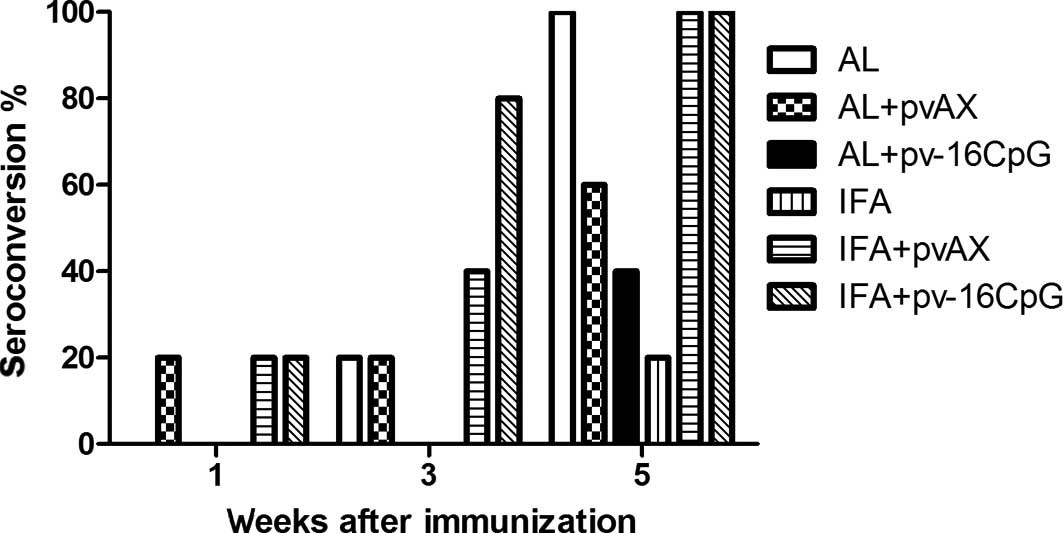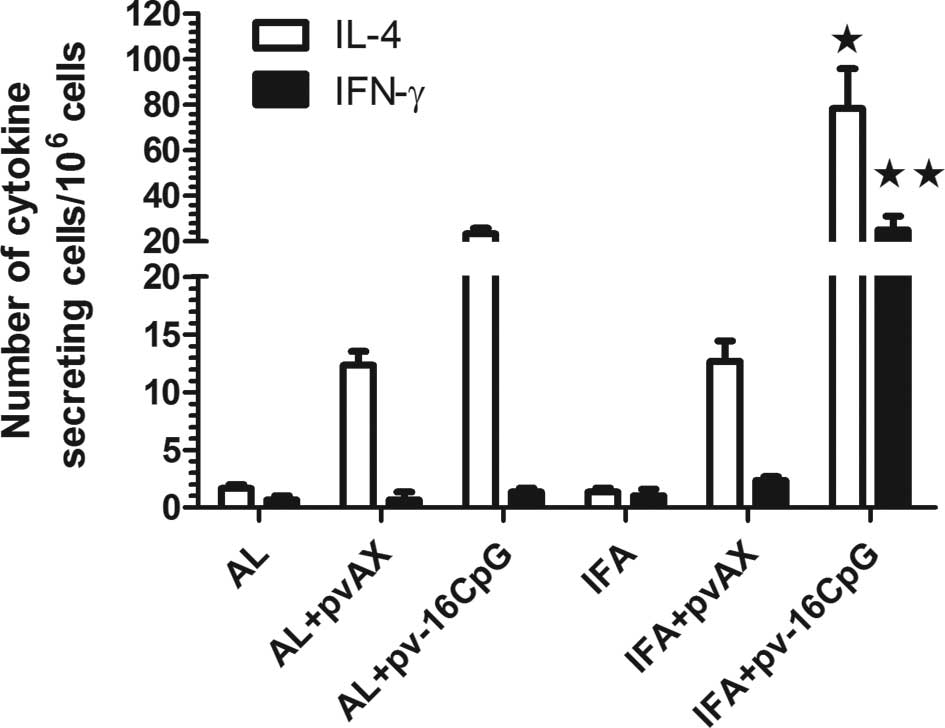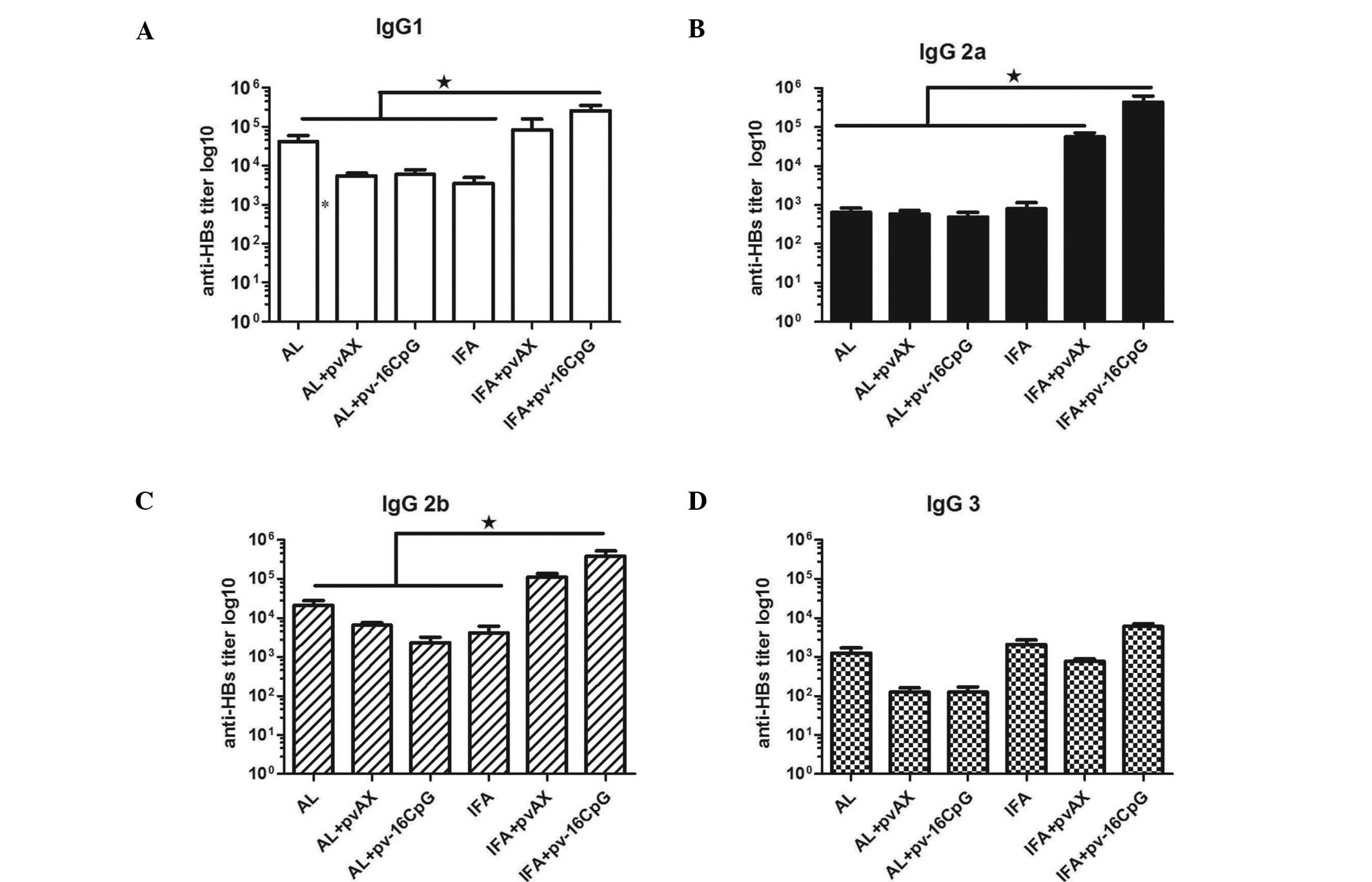|
1
|
Weeratna RD, McCluskie MJ, Xu Y and Davis
HL: CpG DNA induces stronger immune responses with less toxicity
than other adjuvants. Vaccine. 18:1755–1762. 2000. View Article : Google Scholar : PubMed/NCBI
|
|
2
|
Ulmer JB, Valley U and Rappuoli R: Vaccine
manufacturing: challenges and solutions. Nat Biotechnol.
24:1377–1383. 2006. View
Article : Google Scholar : PubMed/NCBI
|
|
3
|
Aguilar JC and Rodriguez EG: Vaccine
adjuvants revisited. Vaccine. 25:3752–3762. 2007. View Article : Google Scholar : PubMed/NCBI
|
|
4
|
Gupta RK and Siber GR: Adjuvants for human
vaccines-current status, problems and future prospects. Vaccine.
13:1263–1276. 1995. View Article : Google Scholar : PubMed/NCBI
|
|
5
|
O’Hagan DT and De Gregorio E: The path to
a successful vaccine adjuvant - ‘the long and winding road’. Drug
Discov Today. 14:541–551. 2009.
|
|
6
|
Stacey KJ and Blackwell JM:
Immunostimulatory DNA as an adjuvant in vaccination against
Leishmania major. Infect Immun. 67:3719–3726. 1999.PubMed/NCBI
|
|
7
|
Jones TR, Obaldia N III, Gramzinski RA, et
al: Synthetic oligodeoxynucleotides containing CpG motifs enhance
immunogenicity of a peptide malaria vaccine in Aotus monkeys.
Vaccine. 17:3065–3071. 1999. View Article : Google Scholar
|
|
8
|
Elkins KL, Rhinehart-Jones TR, Stibitz S,
Conover JS and Klinman DM: Bacterial DNA containing CpG motifs
stimulates lymphocyte-dependent protection of mice against lethal
infection with intracellular bacteria. J Immunol. 162:2291–2298.
1999.PubMed/NCBI
|
|
9
|
Moldoveanu Z, Love-Homan L, Huang WQ and
Krieg AM: CpG DNA, a novel immune enhancer for systemic and mucosal
immunization with influenza virus. Vaccine. 16:1216–1224. 1998.
View Article : Google Scholar : PubMed/NCBI
|
|
10
|
Klinman DM, Yi AK, Beaucage SL, Conover J
and Krieg AM: CpG motifs present in bacteria DNA rapidly induce
lymphocytes to secrete interleukin 6, interleukin 12, and
interferon gamma. Proc Natl Acad Sci USA. 93:2879–2883. 1996.
View Article : Google Scholar : PubMed/NCBI
|
|
11
|
Brazolot Millan CL, Weeratna R, Krieg AM,
Siegrist CA and Davis HL: CpG DNA can induce strong Th1 humoral and
cell-mediated immune responses against hepatitis B surface antigen
in young mice. Proc Natl Acad Sci USA. 95:15553–15558.
1998.PubMed/NCBI
|
|
12
|
Corr M, Lee DJ, Carson DA and Tighe H:
Gene vaccination with naked plasmid DNA: mechanism of CTL priming.
J Exp Med. 184:1555–1560. 1996. View Article : Google Scholar : PubMed/NCBI
|
|
13
|
Kojima Y, Xin KQ, Ooki T, et al: Adjuvant
effect of multi-CpG motifs on an HIV-1 DNA vaccine. Vaccine.
20:2857–2865. 2002. View Article : Google Scholar : PubMed/NCBI
|
|
14
|
Klinman DM, Barnhart KM and Conover J: CpG
motifs as immune adjuvants. Vaccine. 17:19–25. 1999. View Article : Google Scholar : PubMed/NCBI
|
|
15
|
Zhang XP, Yang L, Shi HS, et al: An N-,
C-terminally truncated basic fibroblast growth factor and LPD
(liposome-polycation-DNA) complexes elicits a protective immune
response against murine colon carcinoma. Cancer Biol Ther.
10:276–281. 2010. View Article : Google Scholar
|
|
16
|
Wagner H: Bacterial CpG DNA activates
immune cells to signal infectious danger. Adv Immunol. 73:329–368.
1999. View Article : Google Scholar : PubMed/NCBI
|
|
17
|
Krieg AM: CpG motifs in bacterial DNA and
their immune effects. Annu Rev Immunol. 20:709–760. 2002.
View Article : Google Scholar : PubMed/NCBI
|
|
18
|
Tudor D, Dubuquoy C, Gaboriau V, Lefèvre
F, Charley B and Riffault S: TLR9 pathway is involved in adjuvant
effects of plasmid DNA-based vaccines. Vaccine. 23:1258–1264. 2005.
View Article : Google Scholar : PubMed/NCBI
|
|
19
|
Spies B, Hochrein H, Vabulas M, et al:
Vaccination with plasmid DNA activates dendritic cells via
Toll-like receptor 9 (TLR9) but functions in TLR9-deficient mice. J
Immunol. 171:5908–5912. 2003. View Article : Google Scholar : PubMed/NCBI
|
|
20
|
Gurunathan S, Klinman DM and Seder RA: DNA
vaccines: immunology, application, and optimization. Annu Rev
Immunol. 18:927–974. 2000. View Article : Google Scholar : PubMed/NCBI
|
|
21
|
Cox JC and Coulter AR: Adjuvants-a
classification and review of their modes of action. Vaccine.
15:248–256. 1997. View Article : Google Scholar : PubMed/NCBI
|
|
22
|
Weeratna R, Comanita L and Davis HL: CPG
ODN allows lower dose of antigen against hepatitis B surface
antigen in BALB/c mice. Immunol Cell Biol. 81:59–62. 2003.
View Article : Google Scholar : PubMed/NCBI
|
|
23
|
Mancino D and Ovary Z: Adjuvant effects of
amorphous silica and of aluminium hydroxide on IgE and IgG1
antibody production in different inbred mouse strains. Int Arch
Allergy Appl Immunol. 61:253–258. 1980. View Article : Google Scholar : PubMed/NCBI
|
|
24
|
Jensen FC, Savary JR, Diveley JP and Chang
JC: Adjuvant activity of incomplete Freund’s adjuvant. Adv Drug
Deliv Rev. 32:173–186. 1998.
|
|
25
|
Billiau A and Matthys P: Modes of action
of Freund’s adjuvants in experimental models of autoimmune
diseases. J Leukoc Biol. 70:849–860. 2001.
|
|
26
|
Liaw YF and Chu CM: Hepatitis B virus
infection. Lancet. 373:582–592. 2009. View Article : Google Scholar : PubMed/NCBI
|
|
27
|
Zuckerman JN: Protective efficacy,
immunotherapeutic potential, and safety of hepatitis B vaccines. J
Med Virol. 78:169–177. 2006. View Article : Google Scholar : PubMed/NCBI
|
|
28
|
Kovacs-Nolan J, Latimer L, Landi A, et al:
The novel adjuvant combination of CpG ODN, indolicidin and
polyphosphazene induces potent antibody- and cell-mediated immune
responses in mice. Vaccine. 27:2055–2064. 2009. View Article : Google Scholar : PubMed/NCBI
|
|
29
|
Perrie Y, Mohammed AR, Kirby DJ, McNeil SE
and Bramwell VW: Vaccine adjuvant systems: enhancing the efficacy
of sub-unit protein antigens. Int J Pharm. 364:272–280. 2008.
View Article : Google Scholar : PubMed/NCBI
|
|
30
|
Harandi AM, Medaglini D and Shattock RJ;
Working Group convened by EUROPRIS. Vaccine adjuvants: a priority
for vaccine research. Vaccine. 28:2363–2366. 2010. View Article : Google Scholar : PubMed/NCBI
|
|
31
|
Lindblad EB: Aluminium compounds for use
in vaccines. Immunol Cell Biol. 82:497–505. 2004. View Article : Google Scholar : PubMed/NCBI
|
|
32
|
Sun S, Kishimoto H and Sprent J: DNA as an
adjuvant: capacity of insect DNA and synthetic
oligodeoxynucleotides to augment T cell responses to specific
antigen. J Exp Med. 187:1145–1150. 1998. View Article : Google Scholar : PubMed/NCBI
|
|
33
|
Shirodkar S, Hutchinson RL, Perry DL,
White JL and Hem SL: Aluminum compounds used as adjuvants in
vaccines. Pharm Res. 7:1282–1288. 1990. View Article : Google Scholar : PubMed/NCBI
|
|
34
|
al-Shakhshir RH, Regnier FE, White JL and
Hem SL: Contribution of electrostatic and hydrophobic interactions
to the adsorption of proteins by aluminium-containing adjuvants.
Vaccine. 13:41–44. 1995. View Article : Google Scholar : PubMed/NCBI
|
|
35
|
Gürsel M, Tunca S, Ozkan M, Ozcengiz G and
Alaeddinoglu G: Immunoadjuvant action of plasmid DNA in liposomes.
Vaccine. 17:1376–1383. 1999.PubMed/NCBI
|
|
36
|
Bachmann MF and Jennings GT: Vaccine
delivery: a matter of size, geometry, kinetics and molecular
patterns. Nat Rev Immunol. 10:787–796. 2010. View Article : Google Scholar : PubMed/NCBI
|















